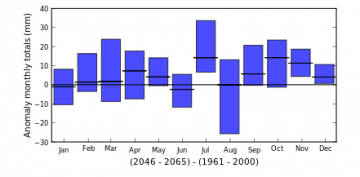Using downscaled climate data


Rainfall anomalies for Juba, South Sudan
To develop suitable adaptation strategies it is important to build up an understanding of what the climate is in the area you are living in and/or working in. This involves using both scientific knowledge and ‘indigenous’ knowledge (accumulated experiential knowledge) of what the climate is in a place / area / region, and what it means for the people living there.
On the scientific side this involves looking at available knowledge and information presented in assessment reports and academic papers, as well as looking at available data – either raw, if you know how to analyze it from scratch, or as presented in useful graphics from which you can more easily interpret relevant messages.
Both observational records (measurements of the historical climate) and downscaled climate projections (indicators of plausible future climates) for stations across much of Africa, South Asia and Southeast Asia are now available from a weADAPT partner in South Africa – the Climate Systems Analysis Group (CSAG) at the University of Cape Town. This data, together with an extensive (and increasing) collection of guidance documentation to help with interpretation, can be accessed through the Climate Information Portal (CIP).
CIP is designed for use by a wide range of users and has been designed to be easy and intuitive to use. If however, having looked at the graphs and the guidance materials in CIP it is still too technical for your liking, then it might be worth befriending a climatologist at your nearest university or the national Meteorological Service to help you make sense of some of the climate data and information that is available for the area where you are working. Or, if you would like to learn more about the climate system, how it works, and how to use climate data and information in facilitating adaptation, then you may like to attend the annual training course run by CSAG and SEI in Cape Town. For details on this contact [email protected]
CSAG and SEI Oxford are currently working together to think about how to link weADAPT and CIP web services so that users can more easily and seamlessly move between resources provided through each site. One way we are doing this is through running “user labs”, where SEI Oxford and CSAG staff work with organisations on specific adaptation projects currently in their portfolio (whether local, regional, national or multi-national) to see how weADAPT and CIP can be used within the project to support different aspects of the adaptation planning process – be it climate vulnerability and risk assessment, multi-stakeholder engagement and communication, identifying and selecting suitable and preferable adaptation options, etc. The first of these user labs are funded through the UN Institute for Training and Research (UNITAR), under the C3D+ programme, and involve working with CIFOR and ENDA.
(0) Comments
There is no content